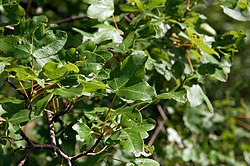Description
Acer monspessulanum is a medium-sized deciduous tree or densely branched shrub that grows to a height of 10 to 15 metres (33 to 49 ft) (rarely to 20 m or 66 ft). [6] The trunk is up to 75 centimetres (30 in) in diameter, with smooth, dark grey bark on young trees, becoming finely fissured on old trees. Among similar maples is most easily distinguished by its small three-lobed leaves, 3–6 cm long and 3–7 cm wide, glossy dark green, sometimes a bit leathery, and with a smooth margin, with a 2–5 cm petiole. The leaves fall very late in autumn, typically in November.
The flowers are produced in spring, in pendulous, yellow to white corymbs 2–3 cm long. The samaras are 2–3 cm long with rounded nutlets. [4] [5]
Subspecies
It is variable, and a number of subspecies and varieties have been described, but few are widely accepted as distinct. The most widely accepted as distinct is Acer monspessulanum subsp. microphyllum (Boiss.) Bornmueller, from Turkey and Lebanon, with smaller leaves not over 3 cm broad. [4]
The species can be mistaken for Acer campestre (field maple), another maple native to Europe, from which it is best distinguished by the clear sap in the leaves (milk-white in field maple), and the much narrower angle between the samara wings. [4] [5]
This page is based on this
Wikipedia article Text is available under the
CC BY-SA 4.0 license; additional terms may apply.
Images, videos and audio are available under their respective licenses.



